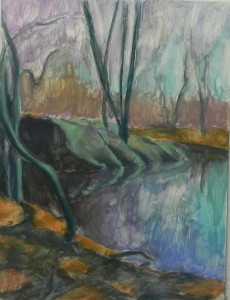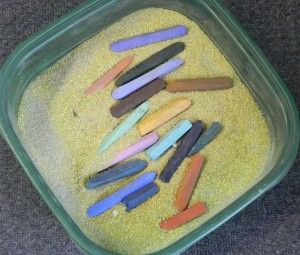The color decisions for this piece were a little tricky. The rocks are basically gray–not a color I relate to very well! I like the warmth of the sky and violets in upper left, and the warm color reflecting in the water. I also like the opportunity to introduce warmer, richer color in the foreground. For the rocks, I decided to use a light cool green to represent the warm sunlit areas, with some light brown added. This will give me a lovely darker, cooler surface over which to apply the warmer lighter pastel. I also used blue greens in the trees. Basically the underpainting is in blue green, blue violet, and warm orangy browns.
In order to maintain my composition, I lay the board flat and applied the alcohol with a smallish brush. I was basically trying to tone the surface. Sometimes it washed away! However, I think I’ve retained the basic structure and feel of the painting and now can take my time with applying the pastel, beginning at the top and working down. I will work both from the black and white and color photos, as needed.
Students have asked me about whether they should be working on all parts at once. I think it depends on the painting. However, when I’ve done an underpainting like this, I know where I’m going and I feel comfortable working slowly in one area. Then I’ll go back and add colors, as needed, to avoid isolated color (this is the fun part!). But, I think that if you rush at this point, you may jeopardize the success of the painting. We’ll see!!!



There is a picture of some pastels in a square bowl in some kind of sand or something. I was wondering what the substance is and for what purpose the chalks are in there? Is this the way you store your pastels or is this just used when you are actually using the pastels? Thank you for you time.
G-Mom of a budding artist.
Peace be with you!
Ilsa–the box with sand is actually a box of cornmeal. This is how I identify the pastels I’m using. And by shaking them, I can clean them off from time to time. It’s nothing very high tech! Just Quaker corn meal.
Jean